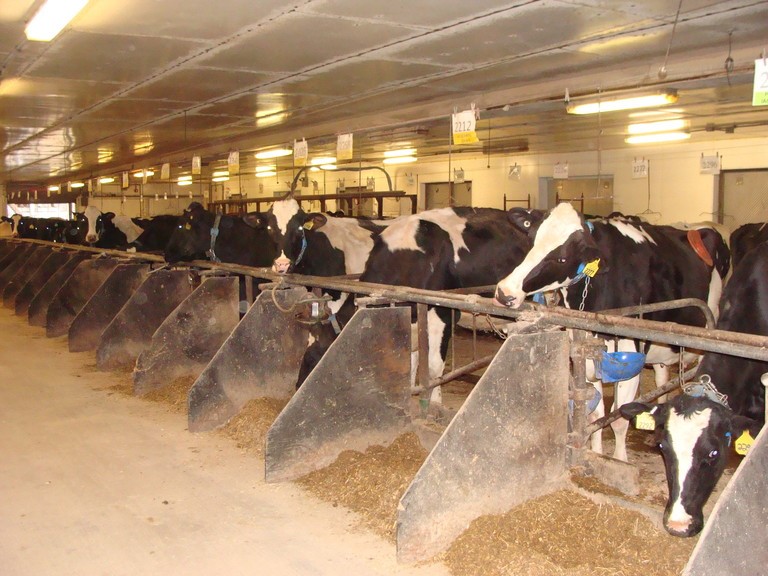Research showing that relatively low dosages of 3-NOP are effective at reducing methane emissions also indicates it may be affordable.
July 24, 2020

The optimum amount of a methane-inhibiting supplement in dairy cattle feed has been determined by an international team of researchers, indicating that widespread use of the compound could be an affordable strategy to mitigate climate change, if farmers embrace it, according to an announcement from The Pennsylvania State University.
Previous studies conducted at Penn State and around the world showed that the addition of 3-nitrooxypropanol (3-NOP) to the feed of dairy cows reduced their enteric methane emissions by about a third. This follow-up research showed that the optimum dose of the compound produced by DSM is 150 mg/kg — about a tablespoon in every 250 lb. of dry feed, Penn State said.
“The maximum mitigation effect was achieved with the three highest 3-NOP doses tested, with no statistical difference among 100, 150 and 200 mg/kg,” said researcher Alex Hristov, distinguished professor of dairy nutrition in Penn State’s College of Agricultural Sciences. “The decrease in methane emission yield in the study ranged from 16% to 36%, and emission intensity reduction ranged from 25% to 45%.”
Three-NOP is the only substance that has worked significantly in reducing enteric methane in cattle and not had unacceptable effects on milk production or quality, added Hristov, who has experimented with many feed additives in recent years.
DSM, which has a patent on 3-NOP, has already applied to European regulators for authorization to sell the compound as a cattle feed additive. The company hopes to launch the product in the European Union soon, followed by registrations in other regions such as Brazil, Australia, New Zealand and Canada. U.S. approval, if it is granted, will come more slowly because 3-NOP is considered a drug and will be regulated by the Food & Drug Administration, the announcement said.
In research conducted at Penn State’s Dairy Teaching & Research Center and reported recently in the Journal of Dairy Science, 49 lactating cows were alternately fed rations containing no 3-NOP or 40, 60, 80, 100, 150 or 200 mg of 3-NOP per kilogram of feed dry matter. Importantly, according to Hristov, dry matter intake and milk yield of the cows was not affected by 3-NOP. As a bonus to the methane mitigation, milkfat concentration and yield increased.
Methane is a natural byproduct of digestion in ruminants that is released into the atmosphere mostly through cows belching. So, the results of 3-NOP trials are viewed by many scientists as critical, if the carbon footprint of dairy and beef cattle production is to be reduced to help slow climate change, Hristov explained.
The climate change contribution of methane from cows has been the subject of considerable derision within the U.S. It is taken seriously in other countries, Hristov said, because the average dairy cow belches approximately 350 lb. of methane each year.
Still, he noted that “greenhouse gases from animal agriculture are just 5% of the total greenhouse gases produced in the United States — much, much more comes from the energy and transportation sectors — so I think it’s a fine line with the politics surrounding this subject. Do we want to look at this? I definitely think that we should, and if there is a way to reduce emissions without affecting profitability on the farm, we should pursue it.”
It is also a matter of improving the overall efficiency of producing milk or meat, he added.
For farmers to use 3-NOP, it must be economical, Hristov noted, so the research showing that relatively low dosages are effective indicates that it may be, although DSM has not set a price on the feed supplement yet.
The question remains: Will the public accept it? “It’s a very small synthetic molecule that is metabolized quickly and falls apart into compounds that are naturally present in the rumen of the cow,” he said.
Also involved in the research were Audino Melgar, doctoral candidate in animal science at Penn State, who was in charge of the study; Katiéli Welter, University of São Paulo, Brazil; Krum Nedelkov, Trakia University, Bulgaria; C.M.M.R. Martins, former visiting scholar in animal science at Penn State; M.T. Harper, former graduate student in animal science at Penn State; S.E. Räisänen, graduate student in animal science at Penn State; Xianjiang Chen, University of Ulster, U.K.; S.F. Cueva, Panamerican Agricultural University, Honduras, and J. Oh, former postdoctoral scholar in animal science at Penn State. Also part of the research team was Stephane Duval, DSM Nutritional Products, Basel, Switzerland.
The U.S. Department of Agriculture’s National Institute of Food & Agriculture and DSM supported this work.
You May Also Like
.png?width=300&auto=webp&quality=80&disable=upscale)


